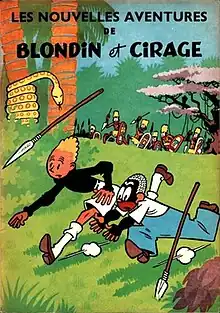| Blondin et Cirage | |
|---|---|
 The title characters on the cover of the fourth album (1947) | |
| Author(s) | Jijé |
| Illustrator(s) | Jijé |
| Current status/schedule | Discontinued |
| Launch date | 1939 |
| End date | 1963 |
| Publisher(s) | Dupuis |
| Genre(s) | Humor comics, Adventure comics |
Blondin et Cirage (Blondin and Cirage, literally Blondy and Shoe polish) is a Belgian humoristic adventure comic strip by Jijé created in 1939 for the Catholic children's magazine Petits Belges.[1] The comic was also published in its Flemish counterpart Zonneland, initially under the name Wietje en Krol, later as Blondie en Blinkie. It stars two boys, Blondin – who is white – and Cirage – who is black.
Concept
Blondin is a white, blond-haired boy who functions as the straight man of the comic. Cirage is a black boy who functions as his comedic sidekick, yet is equally clever; despite Cirage's role of providing comic relief, he is the one who solves the problems the duo encounters, and so can be considered the true hero of the series.[2] They go on several adventures which bring them to the United States, Africa and Mexico.

History
Blondin et Cirage made their debut in the 29th issue of Petits Belges in 1939. They had three adventures during World War II, with Cirage being absent in the last one due to the racial policies of the Nazi occupation. After World War II they reappeared in Spirou where their adventures ran from 1947 until 1963.[3][4][5]
Blondin et Cirage is notable for featuring the first black titular character in a Belgian comic strip. While Cirage has a somewhat stereotypical appearance, the character is otherwise far more clever and sympathetic than most portrayals of black people in Western media at that time.[1][6]
Albums
- 1. Blondin et Cirage en Amérique (Blondin and Cirage in America) (1939)
- 2. Blondin et Cirage contre les gangsters (Blondin and Cirage against the gangsters) (1940–1941)
- 3. Jeunes Ailes (Young Wings) (1942)
- 4. Les Nouvelles Aventures de Blondin et Cirage (The New Adventures of Blondin and Cirage) (1947)
- 5. Blondin et Cirage au Mexique (Blondin et Cirage in Mexico) (1951)
- 6. Le Nègre Blanc (The White Negro) (1951)
- 7. Kamiliola (Kamiliola) (1952)
- 8. Silence! On Tourne (Silence! We're filming) (1953)
- 9. Blondin et Cirage découvrent les soucoupes volantes (Blondin and Cirage discover flying saucers) (1954)
- 10. Le Merveilleux Noël de Blondin et Cirage (The Happy Christmas of Blondin and Cirage) (1963)
In popular culture
In 1998 the characters were commemorated as a comic book wall painting designed by Georgios Oreopoulos et Daniel Vandegeerde, part of the Brussels' Comic Book Route. It can be visited in the Rue Capucine/Capucijnstraat in Brussels.[7][8]
See also
Sources
- 1 2 "Jijé".
- ↑ "Les aventures de Blondin et Cirage". BD oubliées. Archived from the original on 23 April 2000.
- ↑ Patrick Gaumer, Dictionnaire mondial de la bande dessinée, Tours, Larousse, janvier 2001.
- ↑ Thierry Martens, (Tout Jijé : 1938–1940, Belgique, Dupuis, décembre 2001.
- ↑ Delisle, Philippe (1 January 2010). Spirou, Tintin et Cie, une littérature catholique?: années 1930-années 1980. KARTHALA Editions. ISBN 9782811103057 – via Google Books.
- ↑ Delisle, Philippe (1 January 2008). Bande dessinée franco-belge et imaginaire colonial: des années 1930 aux années 1980. KARTHALA Editions. ISBN 9782811100834 – via Google Books.
- ↑ "Blondin – Cirage Comic Strip Wall".
- ↑ "eBru – Mur BD Blondin & Cirage (Jijé) – Bruxelles Pentagone". Archived from the original on 26 September 2016. Retrieved 1 January 2017.